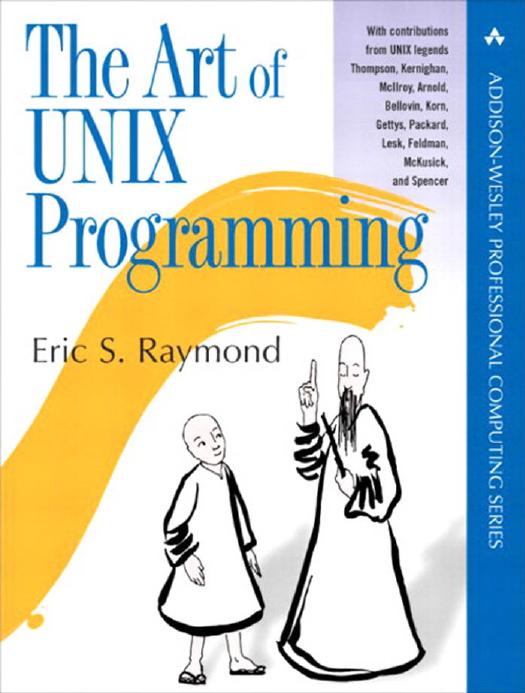The Art of UNIX Programming by Eric S. Raymond

Author:Eric S. Raymond
Language: eng
Format: epub, pdf
Publisher: Pearson Education Limited (US titles)
Published: 2010-03-15T16:00:00+00:00
11.2 History of Interface Design on Unix
Unix predates the modern graphics-intensive style of software interface design. For over a decade after the first Unix in 1969, command-line interfaces (CLIs) on teletypes and dumb text-mode terminals were the norm. Most of the basic Unix toolset (programs like ls(1), cat(1), and grep(1)) still reflect this heritage.
Gradually, after 1980, Unix evolved support for screen-painting on character-cell terminals. Programs began to mix command-line and visual interfaces, with common commands often bound to keystrokes that would not be echoed to the screen. Some of the early programs written in this style (often called ’curses’ programs, after the screen-painting cursor-control library normally used to implement them, or ’roguelike’ after the first application to use curses) are still used today; notable examples include the dungeon-crawling game rogue(1), the vi(1) text editor, and (from a few years later) the elm(1) mailer and its modern descendant mutt(1).
A few years later in the mid-1980s, the computing world as a whole began to assimilate the results of the pioneering work on graphical user interfaces (GUIs) that had been going on at Xerox’s Palo Alto Research Center since the early 1970s. On personal computers, the Xerox PARC work inspired the Apple Macintosh interface and through that the design of Microsoft Windows. Unix’s adaptation of these ideas took a rather more complicated path.
Around 1987 the X windowing system outcompeted several early contenders and prototype efforts to become the standard graphical-interface facility for Unix. Whether this was a good or a bad thing has remained a topic of debate ever since; some of the other contenders (notably Sun’s Network Window System or NeWS) were arguably rather more powerful and elegant. X, however, had one overriding virtue; it was open source. The code had been developed at MIT by a research group more interested in exploring the problem space than in creating a product, and it remained freely redistributable and modifiable. It was thus able to attract support from a wide range of developers and sponsoring corporations who would have been reluctant to line up behind a single vendor’s closed product. (This, of course, prefigured an important theme in the breakout of the Linux operating system ten years later.)
The designers of X decided early on that X would support “mechanism, not policy”. Their objective was to make X as flexible and portable across platforms as possible, while putting as few constraints on the look and feel of X programs as they could manage. Look and feel, they decided, would be handled by ’toolkits’—libraries calling X services linked to user programs. X would also be designed to support multiple window managers,1 and would not require a window manager to have any special privileges or uniquely close integration with X’s machinery.
1 A window manager handles associations between windows on the screen and running tasks. Window managers handle behaviors like title bars, placement, minimizing, maximizing, moving, resizing, and shading windows.
This approach was the polar opposite of that taken by the Macintosh and Windows commercial products, which enforced particular look-and-feel policies by designing them right into the system.
Download
The Art of UNIX Programming by Eric S. Raymond.pdf
This site does not store any files on its server. We only index and link to content provided by other sites. Please contact the content providers to delete copyright contents if any and email us, we'll remove relevant links or contents immediately.
Test-Driven iOS Development with Swift 4 by Dominik Hauser(7898)
Filmora Efficient Editing by Alexander Zacharias(6551)
The Infinite Retina by Robert Scoble Irena Cronin(6057)
Learn Wireshark - Fundamentals of Wireshark. by Lisa Bock(4387)
Linux Device Driver Development Cookbook by Rodolfo Giometti(4006)
Edit Like a Pro with iMovie by Regit(3819)
Linux Administration Best Practices by Scott Alan Miller(2927)
Linux Command Line and Shell Scripting Techniques by Vedran Dakic & Jasmin Redzepagic(2885)
Mastering PowerShell Scripting - Fourth Edition by Chris Dent(2777)
Creative Projects for Rust Programmers by Carlo Milanesi(2611)
MCSA Windows Server 2016 Study Guide: Exam 70-740 by William Panek(2568)
Docker on Windows by Stoneman Elton(2360)
Kali Linux - An Ethical Hacker's Cookbook: End-to-end penetration testing solutions by Sharma Himanshu(2351)
Hands-On AWS Penetration Testing with Kali Linux by Karl Gilbert(2189)
Hands-On Linux for Architects by Denis Salamanca(2119)
Computers For Seniors For Dummies by Nancy C. Muir(2092)
Programming in C (4th Edition) (Developer's Library) by Stephen G. Kochan(2081)
The Old New Thing by Raymond Chen(2033)
Linux Kernel Debugging by Kaiwan N Billimoria(1812)
